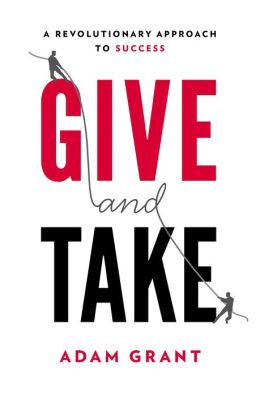Finding and keeping productive people is important to the
health of any organization. Here’s a
question you may not have considered:
When does a person’s individual productivity actually deter
from the overall office or organizational productivity?
 If you haven't pondered this difficult dilemma, it might be
If you haven't pondered this difficult dilemma, it might be
worth some extra consideration because knowing the answer will guide you
towards making better decisions about what is ultimately of greater value in the long term.
One of the simple determiners of those you want to keep
versus those you should consider parting ways with is assessing the "Giver
-vs – Taker" variable. Here is what Steve Wood, President and CEO of the
Leddy Group, recently had to say about this factor. His comments were based on Adam Grant’s
bestseller, Give and Take, A Revolutionary Approach to Success:
"Grant wrote about the findings of Harvard researchers who
studied why some teams in the US intelligence system were more successful than
others. They were surprised to find that the more successful teams were those
that had “giving” rather than “taking” cultures.Here are two important findings from the research:
Many organizations don’t support information sharing.
Worse, in ‘taker cultures’ the norm is for employees to get as much as possible
from others while contributing less in return.The amount of help a groups’ members give one another is
among the strongest predictors of group effectiveness. Building a ‘giver
culture’ pays.Giving and Taking Behaviors
Givers help others, share knowledge, offer to mentor, and,
most importantly, make connections without expecting anything in return. Takers
get things from others without thinking they should give something in return.
Importantly, they only give when they expect to receive personal benefits that
exceed the cost of giving.Most organizational cultures fall in between and are
called “matcher cultures.” In these cultures people help others who help them.
Because this forms isolated groups of people who practice collaboration, they
are less efficient than true giver cultures.Organizational Structure Facilitates Giving Behaviors
In flourishing giver cultures employees are very comfortable
asking for help. One interesting finding by Stella Anderson and Larry Williams
is that 75 to 90 percent of all help exchanged between team members comes from
direct requests for help.However, in many of our organizational cultures today
people are hesitant to ask for help for fear of feeling weak or incompetent,
which they may feel hurts their future advancement.One Structural Idea – Reciprocity Rings
A professor from the University of Michigan, Wayne Baker,
experimented successfully with reciprocity rings. These are 60-90 minute
exercises with groups of employees. During the exercise each person makes a
request for help with their job. Then others with experience or knowledge offer
help and people get matched-up. Everyone has to ask for help with something.This exercise has a number of benefits – 1) It communicates
a norm that it is okay to ask for help; 2) It allows leadership to learn who
are natural givers and takers; and 3) It teaches those who are “takers” the
benefits and skills needed to be a giver.Recruiting and Hiring Givers, Not Takers
Many organizations including Berkshire Hathaway have
policies against hiring takers and they use customized team activities during
the hiring process to screen-out takers. Here are some other ideas for
screening-out takers:Listen for candidates taking personal credit for successes.
They might frequently use pronouns like I and me instead of us and we.Takers often practice “kissing up, kicking down” and when
dealing with powerful people, they become effective fakers, are charming, and
sometimes charismatic. In these cases look for references from people who are
supervisors; okay to ask for different references.Takers often badmouth others. Listen for blaming responses
during interviews.Making Sure Giving Behavior Doesn’t Go Too Far
One drawback of unmanaged giving cultures is that people can
spend too much time giving, and too little time doing their own work.
Successful cultures build-in time limits for giving activity. Others set aside
certain hours for giving or certain hours where no one can be
interrupted."
Reading this material has helped me become aware of the
degree to which this trait characterizes the people with which I am privileged
to work.
How about you? How about your organization? Will knowing
this information aid you in making tough decisions about productive but toxic
people?
Perhaps more research should be done on assessing the collateral damage
that takers have on their organizations.
This would help leaders discern the true pros and cons of keeping (to realize
the benefit of their production) or eliminating (to rid the organization of the
toxicity) takers from their organizations.
I'd love to hear from
you about your experience with both givers and takers and their impact on your
organization.
Join the WorkPuzzle Discussion at the Tidemark Online Community (TMOC)
Engage in the WorkPuzzle discussion by joining the TMOC private social network. Commenting on a public blog like WorkPuzzle can be a little intimidating, so why not join the discussion inside the privacy of the TMOC discussion group?
By joining TMOC, you'll get to see who else is in the group and your comments will only be seen by those whom you trust. Joining TMOC is quick, easy, and free (no kidding…this takes less than 2 minutes). To get started, click here.
Already of a member of TMOC? If so, join the WorkPuzzle Dialog Group by clicking on the WorkPuzzle Group icon on the left side of your TMOC homepage. Questions? Email the WorkPuzzle editor (workpuzzle@hiringcenter.net) and we'll walk through the process.
 Editor's Note: This article was written by Dr. David Mashburn. Dave is a Clinical and Consulting Psychologist, a Partner at Tidemark, Inc. and a regular contributor to WorkPuzzle.
Editor's Note: This article was written by Dr. David Mashburn. Dave is a Clinical and Consulting Psychologist, a Partner at Tidemark, Inc. and a regular contributor to WorkPuzzle.

